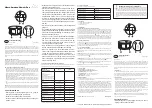
NORA-W36 series - System integration manual
UBX-22021120 - R01
Design-in
Page 13 of 48
C1-Public
3
Design-in
Follow the design guidelines stated in this chapter to optimize the integration of NORA-W36 series
modules in your application board.
3.1
Overview
Although all application circuits must be properly designed, there are several points that demand
special attention during application design. A list of these points, in order of importance, follows:
•
Module antenna connection:
ANT
pad (NORA-W361 only)
Antenna circuits affect the RF compliance of all applications that include the certification
schemes related to the module. To maintain compliance and subsequent certification of the
application design, it is important to observe the applicable parts of antenna schematic and layout
design described in
•
Module supply:
VDD
and
GND
pins.
Supply circuits can affect the RF performance. It is important to observe the schematic and layout
design for these supplies. See also
. Modules normally include several
supply pins described in the pin out of the NORA-W36 data sheet
•
High-speed data interfaces:
UART
.
High-speed data interfaces are a potential source of radiated noise that can affect the regulatory
compliance standards for radiated emissions. It is important to follow the schematic and layout
design recommendations described in the
General high-speed layout guidelines
•
System functions:
nRESET
, GPIO, and other System input and output pins
Careful utilization of these pins in the application design is required to guarantee correct boot up
and system operation. Ensure that the voltage level is correctly defined during module boot. It is
important to follow the schematic and layout design recommendations described in
•
Other pins:
ADC
and NC pins.
Careful utilization of these pins is required to guarantee proper functionality. It is important to
follow the schematic and layout design recommendations described in the
3.2
Antenna interface
The module cannot be mounted arbitrarily. Placement should be chosen with consideration so that it
does not interfere with radio communication. NORA-W366 modules that include an internal PCB trace
antenna
can’t
be mounted in a metal enclosure. No metal casing or plastics using metal flakes should
be used. Avoid metallic based paint or lacquer as well. NORA-W361 modules offer more freedom as
an external antenna can be mounted further away from the module.
⚠
According to FCC regulations, the transmission line, from the module antenna pin to the antenna
or antenna connector on the host PCB, is considered part of the approved antenna design.
Therefore, module integrators must either follow exactly one of the antenna reference designs
used in the module’s FCC type
approval or certify their own designs.














































